This article is a follow-up to the previous article focusing on Ninja Gaiden 3 and its development that you can read here. Happy reading!
At the base of Mount Fuji on the outskirts of Hayabusa village lies the graveyard of blades. Every sword thrust in those grounds a memento to warrior’s lives lost.
As he ventures through this memorial, Ryu Hayabusa finds the blade he laid to rest after having slayed its master: The Blade of the Archfiend. Now he takes it to aid him in his journey, but unlike in Ninja Gaiden 3, Ryu does not toss his older blade aside. Instead wielding it alongside Jinran-maru. Light and darkness.
Immediately ambushed, Ryu jumps into action with his new weapon in hand. He tosses one ninja against a wall with his signature Guillotine Throw, enjoying its long awaited return. As a blade attempts to strike him from behind, he teleports away with his newly acquired Cicada Surge and counters immediately crushing the foes’ limbs with his trusty Lunar staff.
Even with their limbs removed the foes fight on. They are relentless. Just like Team Ninja.
And like the bleeding foe, they are in a critical situation. Wanting to prove that even without the old guard they can still provide a quality action title. Or die trying.
They are on the Razor’s Edge.
(一)
CHAPTER ONE
struggle and development
With the release date set in November 2012, exclusively for the Nintendo WiiU, Team Ninja had seven months to make it happen; the time that most games enjoy a pre-production phase. Instead of enjoying this luxury they had to make quick decisions. What would the new vision be to hopefully steer Ninja Gaiden 3 back to the path of success? What mistakes were made? What’s the goal?
“It seems like we made a Japanese hamburger for the West,” said Ninja Gaiden 3’s director Yosuke Hayashi mere five months before the deadline. “Maybe as a Japanese developer, we need to make good Japanese food, and that’s what people are wanting from a Japanese developer. We really felt that we needed to emphasize our strengths as a developer and push those further, moving forward. Gameplay will be first. We’re not going to offer burgers anymore, but we’re going to offer you damned good sushi. We won’t try and hide who we are anymore. We’re a Japanese developer. That’s us. That’s who we are.“
A clear direction.
Spirits were not yet that high in the whole team though. Despite being one of publisher Tecmo Koei’s best years financially, Ninja Gaiden 3 sold around 630.000 copies on two platforms combined worldwide compared to Ninja Gaiden II’s 1.412.000 sold copies on a single platform. Co-director Fumihiko Yasuda noted, years later, that he “… thought of quitting. I had directed a game which didn’t go so well. I thought that I would give all I had and just quit if it didn’t work out”.
It is a heart wrenching message to receive: that what you wanted to make was not what people wanted to play. Still, the challenge was set and the deadline on the horizon… and Team Ninja got to work.
(二)
CHAPTER TWO
the more things change, the more they stay the same
Focusing again on Team Ninja’s strength, many gameplay focused elements were re-added to the game. Enemies could once again be delimbed and as in Ninja Gaiden II this mechanic adds some randomization to the combat, keeping it fresh. Unlike before though, heads can no longer be removed for an instant-kill, limiting the mechanic’s potential – perhaps in an effort to meet the aforementioned deadline. This limited the potential a tad.
Ryu now also wields some of his beloved weapons aside from his trusted blade. The Lunar Staff (無想新月棍), Eclipse Scythe(闇月鐮刀), Kusarigama(鎖鎌), dual katana Dragon’s Claw and Tiger’s Fang (巌龍、伐虎) and Falcon’s Talons (硬殼猛禽爪) return. Though many weapons from previous entries are still absent, Team Ninja instead focused on condensing the movesets of previous weapons into these six tools of death. Such as the Falcon’s Talons doubling down on mobility by implementing the now absent Tonfa stick’s cancelability; a smart way to lighten the workload and streamline the weapons, making them all unique.
On the flip side, they are all weapons we know and love, with no new weapons or classics returning. The lack of the Kitetsu or long desired newcomers like a pair of Sais, Kali Sticks and Naginata makes it feel like the title is missing that “killer app” compared to its predecessors.
The combat is similarly changed, but familiar. While the basics of light, heavy and ranged attacks are still present, heavy attacks can now be held down and when these attacks connect with a delimbed foe they automatically cancel into an obliteration technique, significantly speeding up the flow of combat allowing for a more freestyle way of play.

Steel on Bone is similarly changed. Enemies will now at times activate a dangerous attack that glows red; hit them with a heavy attack during or shortly after avoiding it and the Steel on Bone chain will start just like before, its bait and punish nature rewarding a more efficient style of play. Unlike before however you can’t chain this murder spree forever, instead being limited by the weapon’s level, capping out at 4 kills.
The enemy-roster is expanded by the inclusion of enemies from previous games like the Van Gelfs and Imps, giving the combat more variation. On the flip side some of these enemies don’t play into the expanded mechanics like Steel on Bone, making fights drag and feel dull while also making the mechanics feel unfinished.
Ninpo sees old favourites return as well, with Wind Blades once again cutting off enemy limbs while Inferno, Piercing Void and the True Inferno focus on killing foes. With each Ninpo having a different sized bar it allows players to strategize, though it would’ve been great to also see some different types of Ninpo return like Flame Wheels that played more into player creativity.
Lastly the Ultimate Techniques return in a similar fashion and now also work on bosses, allowing a safer and efficient strategy for them should players wish it.
Now, it’s tempting to keep on listing these changes. Like how enemies that once pleaded for their lives now fight to their last breath and that Chapter Challenge returns for easy replays. We can also dive into how the new Bloody Rage 業鎖の刻 scoring system aims to reward Steel on Bone use with extra Karma point, which are now used to buy upgrades.
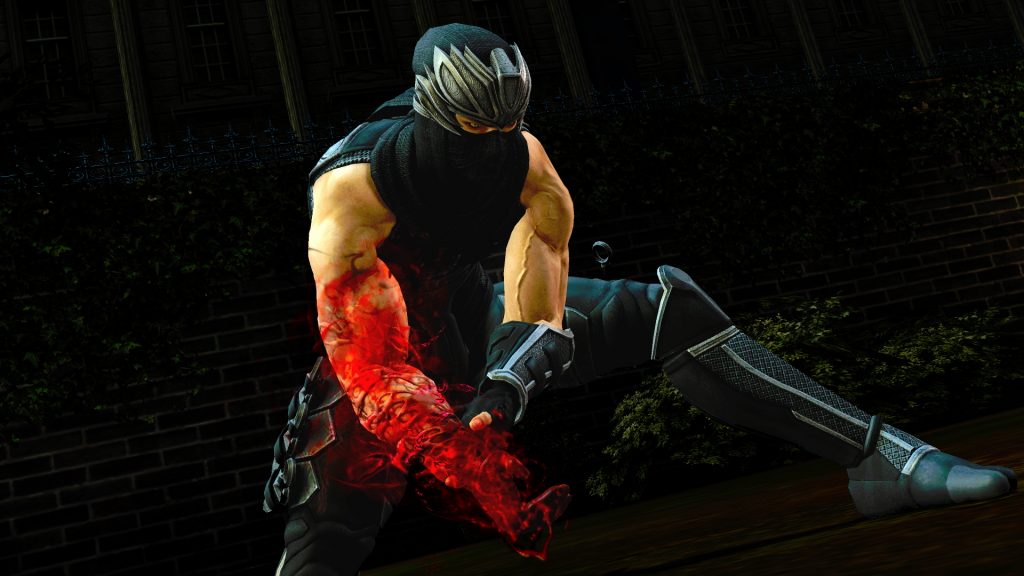
Instead, let’s try to look for the patterns within these changes. If there’s one thing we can take away from the above it’s that Ninja Gaiden 3: Razor’s Edge wants to move forward. It wants to be a new game, with new mechanics, new weapons and reinvented favourites. Only at each step it is held back by the foundation upon which it is built, be it existing mechanics like Steel on Bone needing a place, the tight deadline forcing their hand with weapon selection or enemies not mixing well with established mechanics and weapons, because they have to work with what they have.
Condensing the information above there’s one thing that stands out though, and that’s the disparity of Razor’s Edge’s playstyle. You’ll have seen mention of many styles; freestyle, offensive, defensive, strategy et cetera. Some mechanics, like Steel on Bone, emphasise a defensive style, while the newly improved Falcon’s Talons aim more towards the showman.
This isn’t something new to the series, Ninja Gaiden Black was a game built around efficiency and defence but did have weapons like the Vigoorian Flails that were a tad more freestyle, while Ninja Gaiden II was a game about offensive capabilities, yet featured a strong counter-system and its obliteration techniques also rewarded efficient players. The key difference here being that those two games had a clear core playstyle. Razor’s Edge on the other hand doesn’t aim to fulfill one style, instead promoting them all.
(三)
CHAPTER THREE
a new identity
In the chaos of the fight a player can dodge around, looking for openings for a quick and powerful strike, evading at the last second to get that Steel on Bone in to cull the enemy’s number. Or they can go on the offensive, attacking constantly, stringing Ryu’s ground and aerial moves together while using the new on-landing moves to keep active, with shuriken canceling being more essential than ever before.
Despite not working with all the mechanics, the enemies do try to work with these styles. For example enemies like the once tanky Megaselion can now be baited into a Steel on Bone by pressuring them, while regular soldiers can similarly be baited by holding down charged attacks or healing out in the open. Most enemies do remain the same and some are still overly dodge- and block happy though, which can lead to some ridiculous fights as shown below.
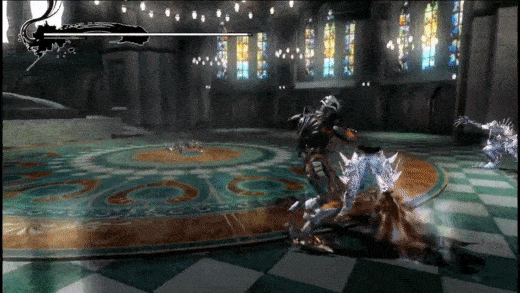
Razor’s Edge shines best when it adds fully fleshed out new elements that do work with what is established. For example, the unlockable Cicada Surge. At any time during gameplay, be it in the middle of an attack animation or not, Ryu can use this move to teleport out of harm’s way at the cost of some Ninpo meter.
This allows players to do the one thing they could not in Ninja Gaiden II; stay on the offensive while attacking. Despite sporting the same enemies, fights that were once about waiting for the perfect opening can now suddenly be approached in the most aggressive manner possible while also offering a fantastic get-out-of-jail option to defensive players.
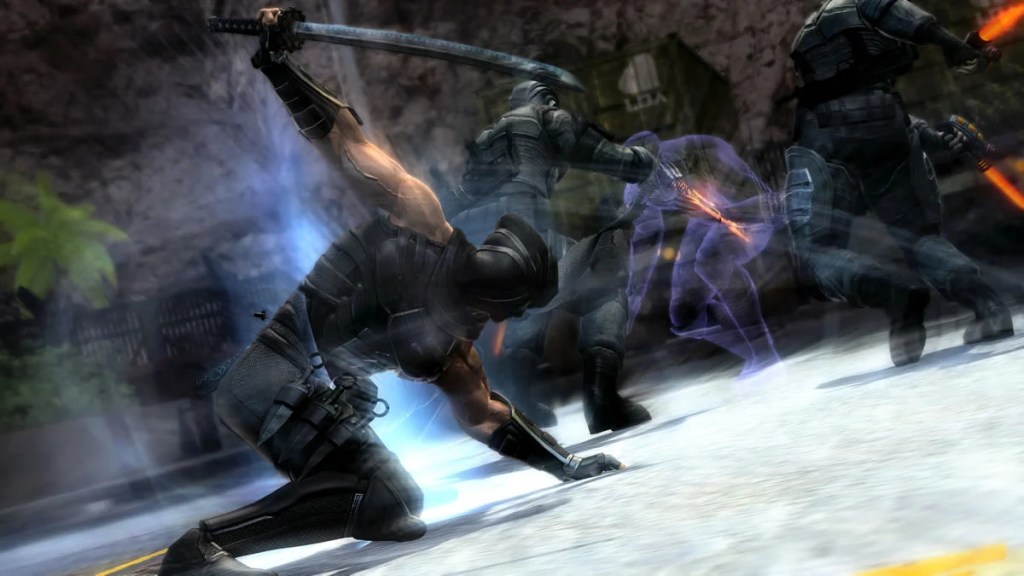
Other new skills include Meditation, the game’s sole healing ability, and Eagle Eye which allows Ryu to take bullet-time-esque shots with his bow in the air. All three cost varying degrees of Ninpo to use.
This cost adds a lot of meter management during combat. Do you take the hit and save your meter for a big Ninpo at the end or do you teleport out of harm’s way? Maybe you want to use it to snipe that archer at a distance with Eagle Eye? Or is there a big boss coming up that you want to enter with full health?
This is further expanded by the altered Ninpo which, as mentioned previously, now have different meter lengths. Piercing Void Ninpo is barely a third of your health in length while True Inferno is a near screen-filling bar before it can be used. Are you going to equip a spell that can be used more often but also requires you to constantly use the meter or do you go for a super long meter that allows for more usage of abilities like Cicada knowing that you’ll probably never see the ability itself? It offers a nice layer of depth and tactical decision making.
Changes like these make Razor’s Edge come more into its own, offering unique combat that isn’t inhibited by what was already present. The word “combat” is emphasised, because while collectible Golden Scarabs are now scattered throughout the world and the dull kunai-climb sections are now sped up, the levels where the combat takes place remain fairly untouched. Sections that once had Ryu clamp his sword arm in pain for a cinematic experience are now replaced with a fight for survival. Each mission now also has a Crystal Skull hidden in plain sight. When activated, an optional trial starts, featuring huge waves of enemies ending in a boss fight against an enemy from a previous title. The game is all combat all the time, showing that Team Ninja did listen to their fan’s desire, though it can lead to the game being a tad exhausting at times.
Razor’s Edge tries to mix it up a bit through the return of Ayane, the Nocturnal Butterfly, with two missions of her own. Aside from Ayane, Momiji returns as well alongside newcomer Kasumi. Unlike in Ninja Gaiden Sigma 2 however these characters have their own mechanics to help them stand out. Ayane is more mobile and has the infamous incendiary shurikens while Momiji can heal others, has a short ranged fireball and a double jump. Meanwhile Kasumi is the only one in the game with a ranged Ultimate Technique and a grab attack that launches enemies in the air, making them all feel like worthwhile additions.
(四)
CHAPTER FOUR
the graveyard spins
When looking at the flow of the game’s combat, it can be hard to nail down since there isn’t a way you’re supposed to play. One player might stay on the defensive, doing nothing but baiting Steel on Bones the whole game long, not once attacking. Others might rush to the offensive, showing off their knowledge of their attacks, having them just clip the foe with a move that sends you skywards to avoid another attack, dodge to the right, jump forward, throw a shuriken, cancel into a flying swallow and canceling out of the enemy’s attack through Cicada – efficiency is nothing in the face of this stylish player. And they’d all be playing the game correctly.
One could note that one method of play mentioned here is less fun than the other, but fun can be an extremely personal thing. One might love being the indestructible turtle that awaits the perfect opportunity to strike, while another gets his kicks from the adrenaline rush that exceeds even its predecessors.
What’s important then is how deep these combat scenarios go. If we zoom out, the combat is surprisingly simplistic. You have a few attack strings, a few evasive maneuvers and a little game of meter-management. Enemies are similarly simplistic, each having only three to four attacks to their name. So what’s the appeal?
Ninja Gaiden, more than ever in Razor’s Edge, puts the focus on having many simple parts work at once, creating depth from having many layers of simplicity as opposed to having a few layers of complexity.

Because of this, no matter how you play or what your preference is, the layers are always present. When on the defence you still play with the numerous ways of evasion and little known tricks to bait out steel on bone, while offensive players can remember enemy patterns and plan accordingly. Due to the size of the encounters however, these enemies remain a threat even when memorized which makes each style interesting.
It is interesting though that while all the rage at the time, Ninja Gaiden 3 does not feature a dodge off-set mechanic, allowing players to dodge and continue a combo where they left off. A feature that would have benefited both defensive, efficient and offensive players, increasing combat options. Instead, Team Ninja opted to shift the balance of power in attack strings. In Ninja Gaiden II each attack was unique with its own up- and downsides. Now, attacks early in the string deal less damage and barely have a chance to amputate a limb, while attacks farther in the string deal massive damage and nearly guarantee a dismemberment. This rewards players skillful enough to pull off one of these attacks in such a hectic engagement.
By doing this, Razor’s Edge also cuts off an efficient strategy from Ninja Gaiden II, namely the abuse of certain key moves with a high chance to delimb a foe. That seems like a deliberate move, as Team Ninja has always been trying to remove overpowered tactics from their challenging games. Its constant attempts to change the Ultimate Technique system is a prime example of this.
This seems like wasted breath however. Overpowered options exist in nearly every title in some respects – from Faust in Devil May Cry V to Dante’s Inferno’s Divine Armour – and removing one dominant strategy simply makes room for another. For Razor’s Edge this is the now infamous ‘Graveyard Spin’ for the Eclipse Scythe, which has led to numerous fun abbreviations for the game such as ‘NG360:RE’ and ‘Ninja Gaiden 360 Why’ – both referencing the input on the Xbox, namely 360+Y.

Ironically, what hurts the game the most is its allowance of every playstyle, as there is no clear direction for players in how they must play. That, paired with a high challenge, leads a large part of the players to hunt down the most efficient option to victory, and there’s always one that slips through the cracks. Had the game offered a more clear playstyle and perhaps offered certain key abilities like Cicada Surge right off the bat, the game might have pulled players in more.
The Graveyard Spin isn’t the only element that slipped through the cracks however. Many of the newly added bosses can be killed in a single loop, at times even by pressing a single attack over and over again. Steel on Bone at times fails to activate, delimbing an enemy instead. And while the game is a tad more responsive than its original release, higher difficulties still slow down significantly and at times drop player inputs with only the 2018 Xbox One version being fully responsive. That’s not to mention the numerous glitches. From the Izuna-drop recovery animation being cancelable, enemies running in circles thanks to pathfinding issues, the game at times activating the old Grip of Murder walking sequences by accident to the famous glitch where a boss might turn into a fighterjet. It is unsurprising due to its tight deadline, yet a sore spot nonetheless.
(五)
CHAPTER FIVE
longevity
Despite its glitchy nature and fast development cycle, the game is absolutely packed with content. If a player wants to beat all difficulty modes, get high-scores on every chapter and conquer all of the game’s nearly 100 mission mode trials, you’re looking at hundreds of hours.
The trials are especially noteworthy. As before, they are almost exclusively bosses jumbled together offering a unique challenge and have the option to attempt them solo always lingering, with only two players having beaten them all by themselves. These challenges do urge players down a more lineair playstyle. A fluid playstyle – while possible – is hardly realistic when you are doing a fifty minute long challenge solo.
Surprisingly, the Survival Mode is once again absent after having been in Ninja Gaiden Sigma 1 and Ninja Gaiden II as downloadable content. A shame, as such a mode would’ve given players a room to continue to improve in. Because if you want to get good enough at Razor’s Edge to be comfortable playing it, especially offensively with all the weapons and characters available and without relying on abusive strategies like the Graveyard Spin… you’re looking at a solid life’s dedication. Which is what some players do, and continue to do. Because once it clicks, and you find your style, the freedom offered by Ninja Gaiden 3: Razor’s Edge is nearly unrivaled.
Though fans were initially lukewarm to the title and overly cautious after the previous entry, players have warmed up more and more to the title in recent years as a result of its strong combat mechanics. Co-director Yasuda said, years later: “for better or worse, the game was a success and the players were happy. It was a hard time for me”. Words that might be echoed by the community at large.
(六)
CHAPTER SIX
conclusion
Razor’s Edge is a unique game. It offers a unique combat system, throws in some enemies and bosses the team had lying around, and due to the tight deadline, hoped it would be okay. And it sort of is. By some miracle each end supplements the core combat.
While the game has definite room for improvement and polish, there’s a fantastic combat system on display here that shows that Team Ninja still has it. It would be interesting to see how they’d build a new action game in the series from the ground up.
That said, currently Ninja Gaiden is on hold. At the time of writing this article there have been no new entries in the series barring the spin-off Yaiba: Ninja Gaiden Z by Spark Unlimited. While Ninja Gaiden has seen small revitalizations in re-releases on the Xbox One through backwards compatibility, the return of the classic NES and Arcade games on modern systems like the Nintendo Switch and a cameo in Nioh’s Bloodshed’s End DLC, the series has mostly remained dormant.
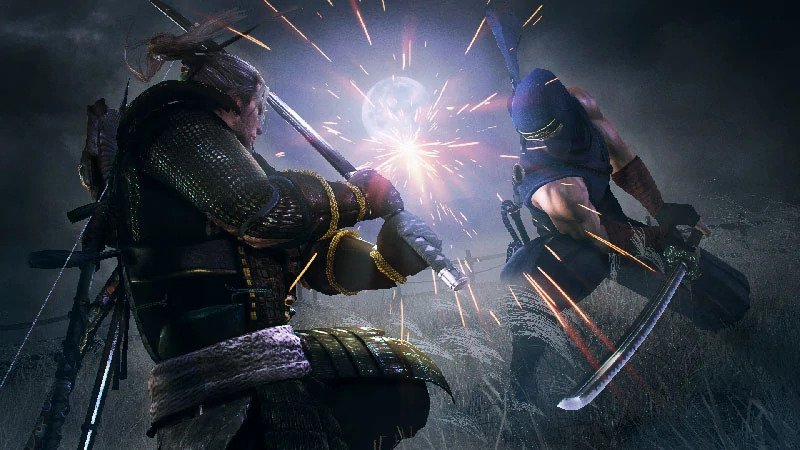
While originally wanting to quit, co-director Yasuda had this to say about the series in 2020: “we are aware that some fans wanted Ninja Gaiden more than Nioh 2. Now we see a lot of ninja games like Sekiro: Shadows Die Twice as well, and we see a lot of good inspirations in those games, so we hope to deliver some good news one day.” Until then it seems other plans lay in wait for Yasuda, Hayashi and co. With Yasuda currently overseeing Team Ninja and Hayashi being promoted to president of the company, the team is focused on getting other Team Ninja titles off the ground while their new series Nioh continues to be a success.
Meanwhile the studio Soleil is helmed by staff members of Ninja Gaiden Black and Ninja Gaiden II, having worked on action games like Samurai Jack: Battle Through Time. Tomunobu Itagaki, the series’ former director, became advisor at Valhalla Studios after his Devil’s Third title wasn’t a success, while recently setting up shop at a studio in Italy.
Maybe one day old wounds will heal and the teams will come together again. Regardless, Team Ninja has proven without a doubt that they are still able to deliver a quality action game. Perhaps one day we’ll witness a new and fully polished title showing the world what they are capable of. Ninja Gaiden 4: The Cutting Edge.
鑒 reflection style 鑒
In this short section I reflect on the article from my own viewpoints as a gamer and lover of the genre instead of a critic.
Ninja Gaiden 4: The Cutting Edge? A man can dream. It’s hard to describe my feelings about having written about all the main Ninja Gaiden games over the last three years. When I wrote the first article I had just entered a new relationship, lost the job that had me enter a depression and gain 40 kilos in weight. Fast forward to 2020 and I’ve lost 30 of said kilograms, am about to be wed and have a promising career ahead of me.
When writing the tale of Ryu’s adventures and Itagaki’s vision behind the first title, I didn’t think I would have such a fantastic readerbase, a forum and even people that would plagiarize my articles. I ended that badly written but extremely passionate article on a personal note. So I wish to do the same here.
Ninja Gaiden 3: Razor’s Edge is a title I have not been kind to in the past, at one point calling it “a pig with lipstick”. Like most people I fell down the hole of not knowing what the game wanted me to do and quickly went the easy way of abusing the infamous 360Y. It wasn’t until years later that I started watching ShowR play the game freestyle that I found I was missing out.
Reading more about the game, its development and actually playing it more in-depth myself I can’t help but wonder just how Team Ninja managed to pull this off. Sure, the enemies aren’t that great, the stages are dull and there are other problems, but the mad men actually turned a title loathed by everyone into one what some might consider the best in the series. In the span of six short months.
Redesigning and tweaking of mechanics aside, which were probably decided in a few meetings, there’s a lot of new content. Just the obliteration techniques alone feature more than 50 new animations for different weapons from different angles, depending on which limb was removed and of which enemy-type. They are done without a single animation being reused from before; downright impressive.
Because notes on Razor’s Edge’s development are very scarce and the studio does not reply to comments about the game or its development process, I can only guess at how they pulled this one off. Are we talking about the team passionately working overtime knowing full well that this is their last chance, or is Razor’s Edge an amalgamation of planned DLC packs for the base game? We can only speculate, and the truth tends to lie in the middle.
For all the damage and drama the series has had to endure during its short three entry tenure, I’d like to close with this statement. While originally depressed by the game, co-director Yasuda now looks back on it more favourably as a moment of learning. Colleague art-director Hirohisa Kaneko had this to say about Yasuda: “Yasuda thinks of the player. It’s probably something he learned from Ninja Gaiden. He thinks of how the player feels, what makes him have fun, I feel that as a director he can really place himself in the player’s shoes” – showing that the lesson was indeed learned. Listen to what your audience and the players want and budget accordingly. Don’t try to twist your original into something for others.
斬 postscript notes 斬
- Though I shortly mention it in the article, I originally intended to dedicate much more time to the game’s scoring system. Called Bloody Rage, each kill Ryu makes increases the rate at which you gain Karma, giving an extra bonus to the multiplier when a foe is killed using a Steel on Bone. I find the mechanic interesting in that it keeps players aggressive, hunting for kills lest the multiplier drop, while also rewarding more defensive players by giving bonus points to Steel on Bone kills. The fact that using an Ultimate Technique stops the chain is also a good way to prevent players from abusing that powerful move. A good system;
- Because most boss fights were quickly ripped from previous games, they don’t play into the mechanics and at times are also changed without much thought. For instance, Alma’s thrown statues are now singular and can be blocked, making them a pointless attack, while the chance of hitting her out of the air is significantly decreased. On the other hand she can now be easily looped to death, like most other bosses. It shows once again how lacking in polish this game is;
- In a way, Razor’s Edge shows just how well designed the enemies and bosses were in the previous games, that they can still work despite being so hastily thrown in;
- To note, the last DLC pack for the base game of Ninja Gaiden 3 released on april 25th of 2012 while the first playable demo of Razor’s Edge, showing Ryu wielding a new weapon, using new ninpo and showing some of the re-added obliteration techniques and re-designed Steel on Bone, premiered june 6th that same year. This really lends credence to the theory that Team Ninja already had a lot of the eventual content planned out, be it perhaps as DLC;
- Hayashi likened the Wii U to an infant whose potential and power won’t be realized until it has had more time to mature. While the WiiU did in fact mature into the very successful Nintendo Switch, Ninja Gaiden hasn’t been fortunate enough yet to grow with it;
- The only unlockable costumes are once again the old standbys. Why the series keeps removing and adding this content is beyond me;
- Though it was released in the United States in November 2012, the title had a very wide release window in other parts of the world. Not releasing in Europe until January while Australia didn’t see the game until May. While one may think so, the game was in fact not censored for these regions, with it getting Australia’s first R18+ sticker on the box;
- Fights now also end with a letter-based rank, grading you on how much damage you took and how quickly you dispatched of your foes, rewarding both a defensive and offensive playstyle. The system only activates on certain fights with no clear indicator on what fight is ranked and which isn’t, not to mention getting S ranks on each fight is seemingly impossible at times. The system feels like a quick addition;
- Though they are nothing alike, I found the correlation behind Ninja Gaiden Black and Razor’s Edge’s development interesting. Both games were made for the fans, not out of an artistic desire. Black was made purely for players that lacked internet on their Xbox, a rarity at the time. Razor’s Edge was made to appease fans that felt the original was lacking;
- I tend to not care for Metacritic scores, but it felt fun to add them here. It’s interesting how these numbers have little bearing on their quality however:
| Game | Critic Score | User |
| NG: Original release | 91 | 88 |
| NG: Black | 94 | 87 |
| NG: Sigma | 88 | 76 |
| NG: Sigma Plus | 72 | 73 |
| NGII | 81 | 80 |
| NG: Sigma 2 | 83 | 78 |
| NG: Sigma 2 Plus | 66 | 75 |
| NG3 | 58 | 50 |
| NG3: Razor’s Edge | 67 | 72 |
源 sources 源
https://www.gamesindustry.biz/articles/2013-01-07-ninja-gaiden-3-director-defends-wii-u
https://www.gamesradar.com/team-ninja-hopes-to-have-good-news-on-ninja-gaiden-in-the-future/
http://archive.videogamesdaily.com/features/interview-new-team-ninja-head-yosuke-hayashi-p3.asp
Postmortems from Game Developer, ISBN 978-1578202140

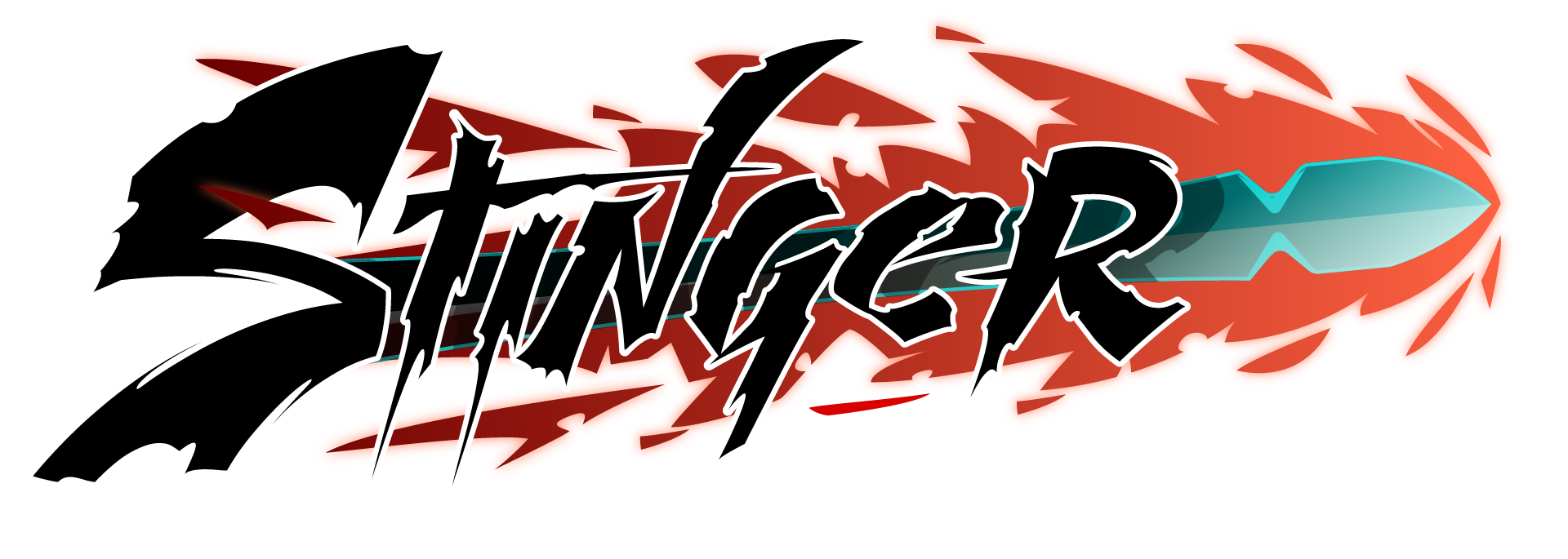


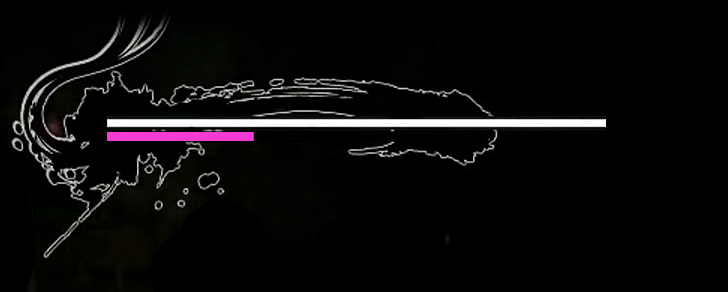

Sounds like an interesting enough game. I’m not in a rush to get this, though. I’m happy with the first two games, for the time being. Hopefully they work on Ninja Gaiden 4 next.
Nioh 2 was surprisingly great, I thought. In fact, the thing that I liked about it was that it did a lot more to encourage you to use all of the mechanics, compared to the original. I played through the whole game while being approximately 30 levels behind most players, so I don’t know how it holds up if you just play it normally. But, for example, the Guardian Spirit mechanic in the original was only there to look cool. I used to say “I’m walking around this supposedly hard game with a nuke in my pocket and yet I can find no reason to use it!”. I remember, I’d be walking around for 5 or 6 missions straight with max heals, max health, maxed out Spirit Gauge, + hundreds of thousands of Amrita, none of which I had any use for. Man, that was boring! Whereas in Nioh 2, the introduction of the Dark Realm, which slows your stamina recovery, ensured that the Spirit Gauge, as well as the new Yokai Abilities, had a legit use. I mean, since your Yokai Abilities use no stamina, they’re very useful in the stamina-slowing Dark Realm, and activating your Spirit Gauge turns you in to a Yokai this time, allowing you to better withstand the Dark Realm.
It was great! The game really needed this. What concerns me, then, is your description of NG3. It sounds dangerously close to Nioh 1, where the mechanics have no real use. I find that kind of thing so boring to play. At the same time, you’ve intrigued me. I want to check this game out now…. I’m just not in a rush to do it, since I still have to beat Master Ninja in NG 1 + 2 🙂
I played (and still own) the original Ninja Gaiden 3. To say I was disappointed with the original game would be an understatement. I was quite crushed at the time actually.
However after reading your articles on Ninja Gaiden 3: Razors Edge and nearly a 8 or 9 year gab since I played Ninja Gaiden 3 on its original release, I kind of want to try Razor’s Edge. Seems like they attempted to really overhaul a game that really needed a clear vision.
Awesome writing, I am really enjoying going through these.
Glad you liked the article man! I would highly recommend Razor’s Edge to any who played and enjoyed the first two titles. It really ups the ante and turns a (imo) turd into one with very fancy lipstick. It’s not there yet, but it shows real heart. Let me know if you end up playing it and what your opinion on it is!
kinda late in the party but really good article,it always amazes me how razors edge was made from the ruins of something so bad.And razors edge is actually one of my favorite ninja gaiden games now
Really great article man,it always amazes how from the ruins of NG3 razors edge was made because honestly its a great game and one of my fav games in general
Thanks man! Glad you liked it 🙂
Yeah NG3:RE is really a diamond in the rough. It still has some shaky foundations, but once you get hooked on its combat it…is kinda hard to put down! You also like the other games?